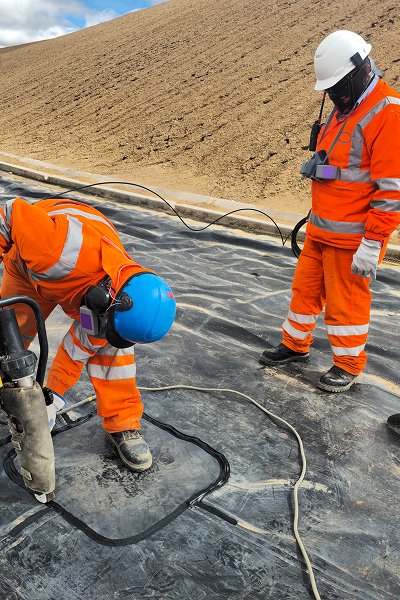Application of geomembrane liner in aquaculture
Geomembrane liner is a thin film material made of synthetic polymers (such as polyethylene, polypropylene, etc.), usually used for water-soil separation, isolation, anti-seepage and other functions. In the field of aquaculture, geomembrane liner is widely used at the bottom and around aquaculture ponds and aquaculture water bodies. Its main function is to prevent the infiltration between water and soil, the loss of pollutants, and ensure the stability of the water quality of aquaculture water bodies.


Features of geomembrane liner:
Excellent anti-seepage performance: Geomembrane can effectively isolate water from soil, prevent harmful substances in water from seeping into groundwater or leaking into the surrounding environment, and reduce pollution to water sources.
Anti-ultraviolet and anti-aging ability: Geomembrane usually has strong anti-ultraviolet and anti-aging properties, and can maintain stable performance under long-term exposure to sunlight and harsh weather conditions.
Chemical corrosion resistance: Since the synthetic materials used in geomembranes have strong chemical stability, they can withstand corrosion from various chemicals in water, and are especially suitable for use in water bodies containing corrosive substances.
High strength and flexibility: Geomembrane has high tensile strength and ductility, can adapt to the irregular surface of the bottom of the pond, and can withstand certain mechanical pressure.
Application fields of geomembrane liner
Anti-seepage of aquaculture ponds: Geomembrane liner is mainly used for anti-seepage of the bottom and surrounding of aquaculture ponds to avoid water loss and ensure the stability of aquaculture water bodies. At the same time, geomembranes can also prevent aquaculture wastewater from leaking into the groundwater layer and reduce pollution.
Water pollution control: If the waste and residues in the aquaculture process are not effectively treated, it is easy to cause water pollution. The use of geomembranes can effectively control the spread of aquaculture wastewater and protect the surrounding waters and environment.
Anti-seepage control of landfills: In addition to the field of aquaculture, the application of geomembranes in landfills is equally important. Its anti-seepage function can prevent the leachate from polluting the groundwater. Similar technologies can be applied in farms to ensure that the waste in the aquaculture process does not cause secondary pollution to the environment.
Management and optimization of aquaculture systems: By using geomembranes, aquaculture can be carried out more scientifically and environmentally friendly. For some efficient recirculating aquaculture systems (RAS), geomembranes can provide additional anti-seepage protection to ensure the stability of the water circulation system.


Types and methods of freshwater aquaculture
Pond aquaculture: Pond aquaculture is one of the most common freshwater aquaculture methods. Aquaculture ponds can be reconstructed from natural waters or completely artificially excavated ponds. Depending on the species being cultivated, the construction and management methods of the ponds vary.
Cage aquaculture: Cage aquaculture is the hanging of cages or other containers in the water body to cultivate aquatic animals. Cage aquaculture is usually used in large water bodies, especially in natural environments such as lakes and rivers, and can effectively utilize water resources.
Circulating aquaculture system: This is a modern aquaculture model that uses a series of equipment to circulate and purify the aquaculture water body to maintain good water quality and increase the aquaculture density. Common recirculating aquaculture systems include aquaculture circulating water treatment systems (RAS), which are suitable for high-density aquaculture models.
Integrated breeding model: This model refers to the mixed or complementary breeding of multiple aquatic organism
Main issues and challenges in freshwater aquaculture
Water quality management: Water quality is one of the key factors affecting aquaculture production. Deterioration of water quality not only affects the growth of farmed species, but may also lead to disease outbreaks and economic losses. Common water quality problems include insufficient dissolved oxygen, excessive ammonia nitrogen concentration, abnormal pH value, etc.
Disease prevention and control: Disease prevention and control in aquaculture has always been a difficult problem in the industry. Factors such as excessive stocking density, improper environmental management, and pathogen transmission may cause farmed animals to become sick and affect the benefits of farming.
Resource and environmental pressure: The consumption of water resources in the farming process is relatively large, especially in arid areas, and water shortages may affect the sustainability of farming. At the same time, waste generated during the farming process (such as feces, feed residues, etc.) may pollute the surrounding environment.s in the same water body or pond, such as fish and shrimp, fish and algae.
Freshwater aquaculture and geomembrane liner
Improving aquaculture benefits: By using geomembrane liners, excessive loss and pollution of water bodies can be prevented, and the water quality stability of aquaculture water bodies can be improved, thereby improving aquaculture benefits.
Environmental protection and sustainability: Geomembrane liners effectively reduce the pollution of water bodies to the surrounding environment, making aquaculture more environmentally friendly and sustainable. Its anti-seepage and isolation effects can protect water resources from pollution and ensure the long-term health of the ecological environment.
Technological innovation: With the continuous innovation of technology, geomembrane materials are also being continuously optimized and their performance is gradually improving. In the future, more efficient and environmentally friendly geomembrane materials may appear, further promoting the modernization and environmental protection of aquaculture.
The combination of freshwater aquaculture and geomembrane liner provides a more stable, environmentally friendly and efficient production environment for aquaculture. The application of geomembrane technology will promote the sustainable development of aquaculture, improve the production efficiency of aquatic products and protect the ecological environment.


